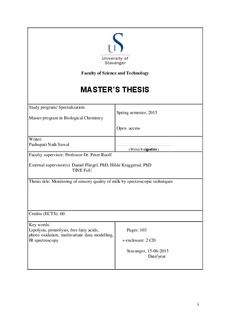| dc.description.abstract | The combined use of spectroscopic analysis and chemometric tools has wide application in evaluating and monitoring the product sensory qualities. The main intention of the work was to better understand the use of a spectroscopic technique in evaluating the changes in fluid milk when quality is reduced during storage or by special reasons. In addition, to study the possibility of correlating infrared (IR) spectroscopy results with the sensory quality changes in milk. This was done by storing milk samples for three consecutive weeks, agitating pasteurized milk with and without raw milk addition, exposing milk samples to different wavelengths of light (300-800 nm) using different color filters and storing milk samples at three different temperature for a week and one specific temperature for one day.
Stored milk samples at 4 oC were analyzed weekly with sensory and spectroscopic technique. Sensory analysis showed that dairy and age of milk had significant effect (p<0.05) on the quality of milk and on free fatty acids (FFA) formation. It was observed that low-quality score was mainly due to off-flavor, harsh, rancid and sickening flavor. However, the sensory attributes didn’t change very much even after the storage for three weeks. The calibration model (R2=0.382) indicates that small changes in sensory quality is difficult to measure by FTIR spectroscopy.
Pasteurized milk when agitated at 15 oC for 0, 15 and 45 minutes with and without addition of 1% raw milk, the sensory analysis showed significant effect (p<0.05) between dairies and raw milk addition with quality score and rancid attribute. The FFA formation was greatly enhanced by raw milk addition rather than agitation time and the effect was clearly visible after 5 days. By IR spectroscopy, it showed that quality score had been affected by rancid off flavor. The calibration model with quality score and rancid was found to be R2=0.825 and 0.801. It shows much information about sensory quality and rancidity which can be calibrated by FTIR.
Pasteurized milk when exposed to blue light (400-500 nm), it got absorbed by riboflavin and orange light (575-750 nm) absorbed by tetrapyrroles. Green light (450-600 nm) didn’t promote photo-oxidation of riboflavin and tetrapyrroles. Sensory analysis showed that filters used for light exposure and time interval had a significant effect (p<0.05) on quality score and oxidized flavor in the milk. Reference sample showed high quality with less oxidation in compare to
v
unwrapped samples. It was observed that orange filter absorbing light longer than 575 nm induced more off flavor than blue filter.
However, by IR spectroscopy with calibration model R2=0.391, it showed that low sensory quality, caused by oxidized off-flavor was best measured when riboflavin was degraded by blue light. Tetrapyrrole degradation causing oxidized off-flavor, can probably not be measured by FTIR.
When pasteurized milk was stored at different temperatures, sensory analysis showed that dairy and temperature had significant effect on quality score. Milk samples stored at 4 oC for 7 days had better quality than 6 days at 4 oC plus 1 day at 17 oC. It was observed that quality score had been affected by bitter, sour, rancid and off-flavor defects. Furthermore, the calibration model from IR spectroscopy with quality score was found to be R2=0.282.
Finally, the combined merged datasets of sensory and spectroscopy showed a good correlation model with quality score (correlation coefficients= 0.51).
In conclusion, FTIR technique can be useful to apply as screening tool for evaluating quality of milk samples. However, for the total sensory quality, this method can’t be applicable as it can’t detect all possible sensory defects in milk. | nb_NO |

